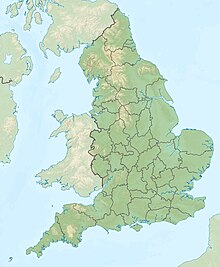Battle of Neville's Cross
| Battle of Neville's Cross | |||||||
|---|---|---|---|---|---|---|---|
| Part of the Hundred Years' War and the Second War of Scottish Independence | |||||||
 Battle of Neville's Cross from a 15th-century Froissart manuscript (BN MS Fr. 2643). |
|||||||
|
|||||||
| Belligerents | |||||||
|
|
|
||||||
| Commanders and leaders | |||||||
|
|
William Zouche, Archbishop of York |
||||||
| Strength | |||||||
| 12,000 | 6,000-7,000 | ||||||
| Casualties and losses | |||||||
| 1,000- 3,000 killed and many captured. | Very few killed | ||||||
|
|
|||||||
The Battle of Neville's Cross took place to the west of Durham, England, on 17 October 1346. The battle was the result of the invasion of France by England whereupon, under the terms of the Auld Alliance, the Scottish invasion of northern England was required during the Hundred Years War and the Second War of Scottish Independence. The battle ended with the rout of the Scots and the capture of their king, David II of Scotland. Notwithstanding the Scottish defeat, this sacrifice is generally regarded as crucial to the longer-term goal of securing English recognition of Scottish independence.
In 1346, England was embroiled in the Hundred Years' War with France. In order to divert his enemy, Philip VI of France appealed to David II of Scotland to attack the English from the north in order to create a second front for the English. The request from Philip VI came during an unstable time in the reign of David II. The English crown under Edward III did not recognize David II’s authority, instead supporting the compliant Balliol cause in the hope of re-establishing dominance over Scotland. The young king had only returned from Château Gaillard in Normandy 5 years previously at age 17 after having to flee after his father’s death. The treaty of Edinburgh of 1328 had cemented Scotland’s independence under Robert I’s rule only to fall apart with his death in 1329 and had still not been reestablished by David II's return in 1341.
Despite Philip VI's especially desperate pleas in June 1346, two months before the French defeat at Créci, (when the English were amassing troops in southern England), David II of Scotland waited until October, when he felt few English troops would be left to defend lucrative Northern English cities. Waiting until he believed most English troops were fighting France and with winter approaching, David II of Scotland invaded England as a response to England's invasion of France.
...
Wikipedia

